Occupational diseases statistics
Data extracted in December 2023.
Planned article update: December 2024.
Highlights
Between 2013 and 2021, the EU index value for the number of (newly) recognised persons as having an occupational disease declined overall by 26%.
In the EU, the number of (newly) recognised persons as having synovitis and tenosynovitis (inflammation of the synovial lining of a joint or tendon sheath) and other enthesopathies (inflamed and painful joint) increased between 2013 and 2021 by 13% and 1%, respectively.
Development of occupational diseases – total and groups, EU, 2013-2021
This article presents a set of main statistical findings in relation to indicators concerning occupational diseases in the European Union (EU). The statistics presented are experimental. The data for the EU are based on (at most) information for 24 EU Member States: excluding Germany, Greece and Portugal.
For reasons of comparability, the focus of the analysis in this article is on developments over time. The time series are shown using an index, referenced to 2013 = 100. As such, the article does not show the absolute number of people recognised as having an occupational disease but focuses on the change in this number over time.
Country profiles for individual EU Member States are available on Eurostat's website in the relevant dedicated section. The country profiles show the national situation in relation to a 'core list' of occupational diseases. The occupational diseases included in the core list were selected from those most often reported by the countries participating in the development of these experimental statistics. The criteria considered were a) a significant number of cases and b) recognition by the majority of the participating countries.
Full article
Overall developments
Figure 1 shows the development of the total index of the number of people recognised as having an occupational disease as well as information for four aggregate indices for groups of occupational diseases.
Between 2013 and 2021, the total index for the number of people recognised as having occupational diseases declined overall by 26 %. Among the four groups of diseases for which aggregate indices are available, the largest decreases were observed for pneumoconiosis (down 51 %) and contact dermatitis (down 50 %). There were noticeable decreases for selected occupational cancers (down 27 %) and selected musculoskeletal disorders (also down 27 %).
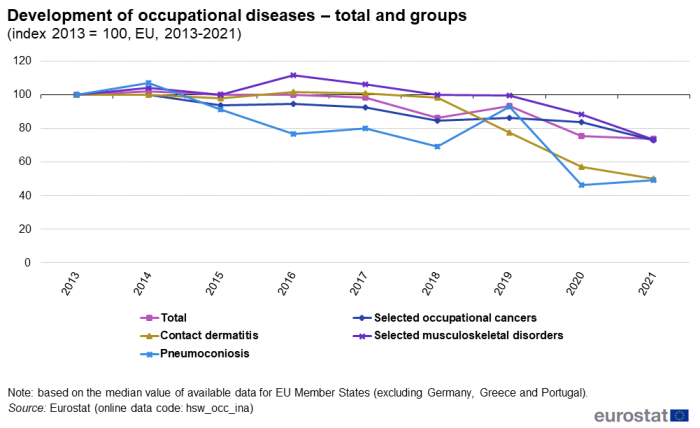
(index, 2013 = 100)
Source: Eurostat (hsw_occ_ina)
Developments for specific diseases
Figure 2 shows that the index of the number of people recognised as having one of the occupational diseases fell at a faster than average pace between 2013 and 2021 in three specific diseases:
- for asthma the index was down 49 %;
- for other diseases of the inner ear it was down 54 %;
- for pleural plaque (the pleura is a membrane surrounding the lungs and lining the rib cage; exposure to asbestos can cause a thickening of the membrane) it was down 55 %.
The decrease for pleural plaque was the second largest decrease (among the 16 diseases covered by this article) between 2013 and 2021, while the decrease for other diseases of the inner ear was the third largest decrease.
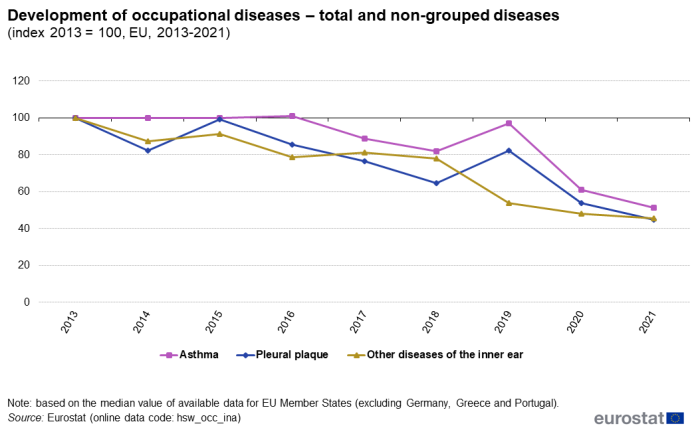
(index, 2013 = 100)
Source: Eurostat (hsw_occ_ina)
Figure 3 presents data for two selected occupational cancers: malignant neoplasms of the bronchus and lung, and mesothelioma (a malignant tumour that is caused by inhaled asbestos fibres and forms in the lining of the lungs, abdomen or heart). The number of people recognised as having these occupational cancers was at a lower level in 2021 than in 2013, down 16 % for mesothelioma and 40 % for malignant neoplasms of the bronchus and lung.
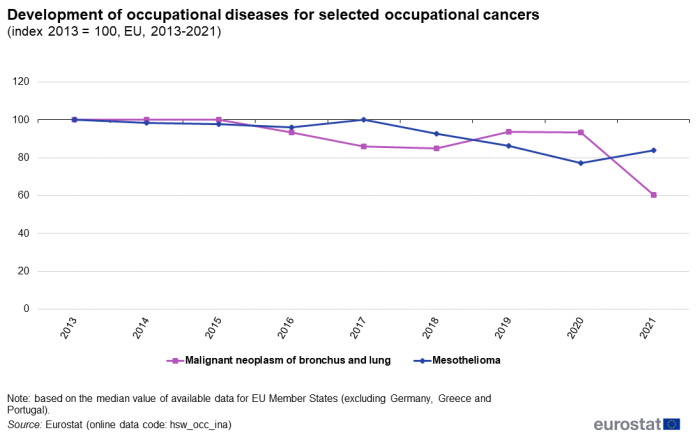
(index, 2013 = 100)
Source: Eurostat (hsw_occ_ina)
Pneumoconiosis is a group of diseases caused by the inhalation of dust. Indices for two sorts of pneumoconiosis are presented in Figure 4, the first relating to mineral fibres (such as asbestos) and the second to dust containing silica (silicon dioxide). The indices for the number of people recognised as having pneumoconiosis were lower in 2021 than they had been eight years earlier, down 52 % for pneumoconiosis due to asbestos and other mineral fibres and down 48 % for pneumoconiosis due to dust containing silica.
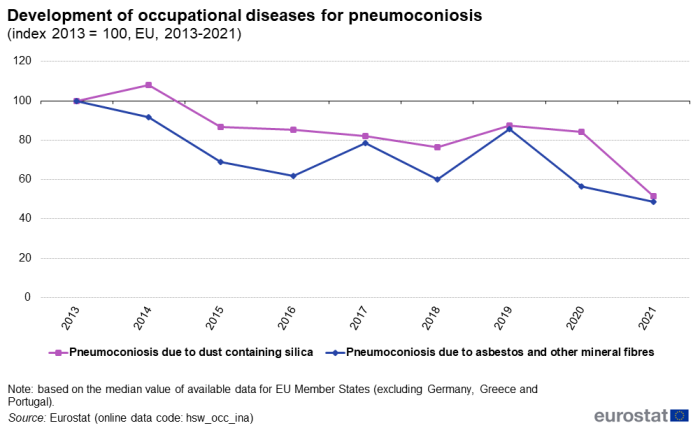
(index, 2013 = 100)
Source: Eurostat (hsw_occ_ina)
Contact dermatitis is a type of skin disease provoked by contact with a particular substance, with the skin typically becoming dry, blistered or cracked. Such dermatitis can be caused either by an irritant (something which damages the skin) or an allergen (something which provokes an immune response which damages the skin). Figure 5 shows that the number of people recognised as having these occupational diseases was at a lower level in 2021 than in 2013, down 49 % for the allergy-based variant and 33 % for the irritant-based variant.
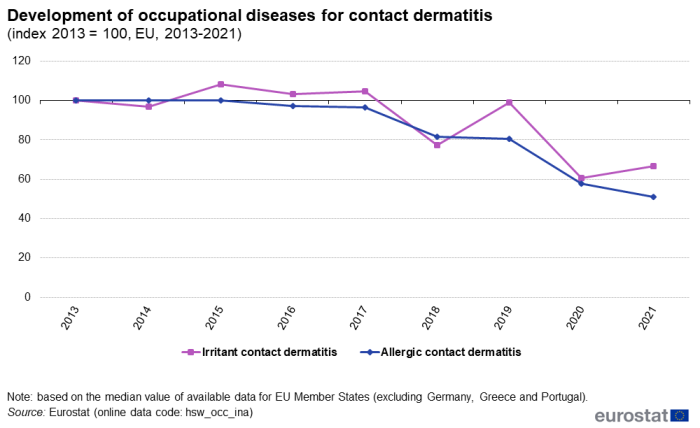
(index, 2013 = 100)
Source: Eurostat (hsw_occ_ina)
The final figure, Figure 6, presents developments for seven selected musculoskeletal disorders. Among these, two occupational diseases / conditions recorded the fifth largest and the largest decreases (among the 16 diseases covered by this article) between 2013 and 2021: the number of people recognised as having soft tissue disorders (such as muscle or tendon injuries) related to use, overuse and pressure was down 62 %, while the number of people recognised as having other peripheral vascular diseases (blood circulation disorders) was down 50 %. These seven selected musculoskeletal disorders also included the only two occupational diseases (among the 16) with a higher index value in 2021 than in 2013: synovitis and tenosynovitis (inflammation of the synovial lining of a joint or tendon sheath; up 13 %), and other enthesopathies (inflamed and painful joints; up 1 %).
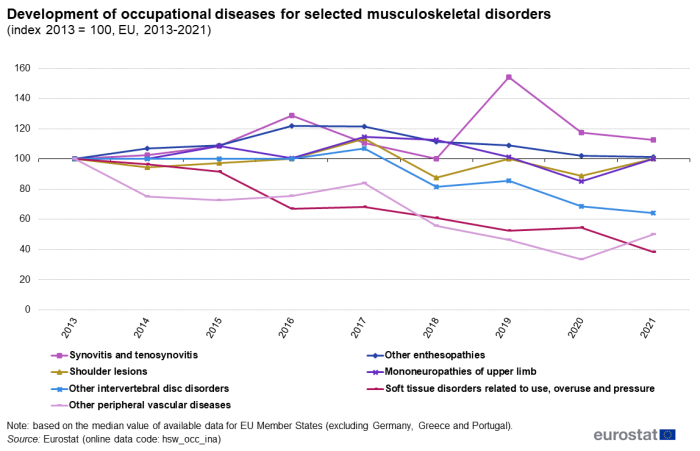
(index, 2013 = 100)
Source: Eurostat (hsw_occ_ina)
Feedback
To help Eurostat improve these experimental statistics, users and researchers are kindly invited to give us their feedback by email
Source data for tables and graphs
Data sources
Legal basis
Occupational disease statistics are based on administrative data collected nationally by various organisations, usually the national statistical offices. Regulation (EC) No 1338/2008 outlines the domain specific requirements of the data collection, for example in terms of the aim, scope, subjects covered, reference periods, intervals and time limits for data provision and metadata.
Geographical coverage
Germany and Greece did not take part in the pilot data collection while Portugal provided data for 2013–2015. As such, the data used to compile the indices for the EU are based on the availability among at most 24 EU Member States; the precise number varies between the individual diseases.
Core list of diseases
The core list (also referred to as the short list) of occupational diseases is composed of 16 diseases, of which 13 are presented in four (aggregated) groups.
- Selected occupational cancers
- C34 Malignant neoplasm of bronchus and lung
- C45 Mesothelioma
- Pneumoconiosis
- J61 Pneumoconiosis due to asbestos and other mineral fibres
- J62 Pneumoconiosis due to dust containing silica
- Selected musculoskeletal disorders
- G56 Mononeuropathies of upper limb
- I73 Other peripheral vascular diseases
- M51 Other intervertebral disc disorders
- M65 Synovitis and tenosynovitis
- M70 Soft tissue disorders related to use, overuse and pressure
- M75 Shoulder lesions
- M77 Other enthesopathies
- Contact dermatitis
- L23 Allergic contact dermatitis
- L24 Irritant contact dermatitis
The following three occupational diseases do not belong to any of the four (aggregated) groups identified above:
- H83 Other diseases of the inner ear
- J45 Asthma
- J92 Pleural plaque
Variables collected
Although not presented in this article, the following information is requested for each recognised occupational disease case:
- sex;
- age at the time of recognition of the occupational disease;
- employment status during the period of harmful exposure;
- occupation during the period of harmful exposure;
- economic activity of the employer;
- severity;
- exposure factor.
Calculation of the EU index
For each disease or (aggregated) group of diseases, the number of recognised cases is tabulated, showing the number for each year (from 2013–2021) for each EU Member State (among at most 24 Member States, for which data are available). Then, for each year and for each EU Member State, an index is calculated with a fixed base, namely the value for 2013. The EU index value is the median calculated across the Member States index values, for each year. The variations of the absolute numbers of recognised cases do not have a direct impact on the median values and implicitly on the EU index which does not reflect the evolution of the absolute numbers as such. The EU index value for 2013 equals 100 by default. More details are available in a methodological note.
Experimental nature
The experimental nature of these statistics is mainly related to the fact that the data on recognised cases of occupational diseases reflect not only the occurrence of such diseases, but also the way in which the concept of occupational disease has been integrated into national social security systems. The existence of different legal systems and procedures for the recognition of occupational diseases in the EU makes comparisons difficult, noting that a low number of recognised cases of an occupational disease in a given EU Member State is neither a sign of the absence of such a disease nor necessarily a clear proof of successful prevention. In the same way, well-established detection systems and large-scale information campaigns could explain the high numbers of reported and recognised cases in some countries.
Context
EU statistics on occupational diseases are essential elements in the European Commission's strategy to assess the efficiency of EU legislation on health and safety at work. To improve the working conditions, knowledge of the numbers, rates, frequencies and trends of occupational diseases are fundamental. They allow preventive actions across the EU to be monitored and prioritised.
At the present time, there is not an EU-wide database concerning statistics on occupational diseases. The objective of the EU's pilot exercise in this area is to respond to the need for data by gathering national data in a single database and from this starting point to provide information on the developments concerning the most commonly recognised occupational diseases within the EU. These requirements are underlined in Regulation (EC) No 1338/2008 of the European Parliament and of the Council of 16 December 2008; annex V. Beyond providing information on the occurrence of diseases, these data could potentially provide other useful information regarding causality (exposure and medical consequences), which is needed for the prevention and evaluation of occupational diseases. The pilot data collection aims to support further development of the EU's occupational diseases statistics.
Note for reference years 2020 and 2021
With the COVID-19 pandemic, preventive measures were put in place with the aim of limiting the spread of the Coronavirus and to combat the epidemic. Some of these measures resulted in activities being either completely stopped or restricted by many employers. In some cases, employees were encouraged or obliged to work remotely, for example from home. For the economic sectors where activity was stopped or reduced, the number of accidents decreased. Inactivity or reduced activity in certain sectors resulted in a smaller number of workers and/or working hours. Consequently, there was an atypical decrease in the number of reported occupational diseases. By contrast, in certain other sectors the COVID-19 pandemic generated an increase in activity, for example, for human health activities, residential care activities or social work activities without accommodation. The increased activity in sectors such as these generally generated higher numbers of reported occupational diseases (or reported accidents at work in some countries) when the cases of COVID-19 of occupational origin were included according to national practices and legislation. Public services that deal with the administrations in charge of receiving notifications, reporting, investigations and recognition of occupational diseases may have operated with limited capacities. The impact of all the actions described above led to a decrease in the total number of short-listed occupational diseases in the data collected for reference years 2020 and 2021 (compared with 2019 and the previous years for which data are available).
Direct access to
- Health, see:
- Health and safety at work (hsw)
- Occupational diseases (from 2013 onwards; source: EODS) (hsw_occ)
- EU index of occupational diseases (2013=100) – experimental statistics (hsw_occ_ina)
- Occupational diseases (from 2013 onwards; source: EODS) (hsw_occ)
- European Agency for Safety and Health at Work
- European Commission – Employment, Social Affairs and Inclusion – Health and safety at work
- European Commission – Employment, Social Affairs and Inclusion – Health and safety at work – EU strategic framework (2021–2027)
- European Foundation for the Improvement of Living and Working Conditions (EUROFOUND) – Health and well-being at work
- International Labour Organisation (ILO) – Safety and health at work